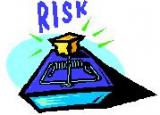Exposure & Fate Assessment Screening Tool (E-FAST) Version 2.0 Computer-Based Training Introductory Course
Fate Assessment Screening Tool (E-FAST) Version 2.0 Computer-Based Training Introductory Course
PLEASE NOTE THIS COMPUTER-BASED TRAINING MODULE WAS DEVELOPED USING THE PREVIOUSLY RELEASED E-FAST2. THE NEW VERSION (2014) CONTAINS THE SAME USER INTERFACE, WORKFLOW AND CALCULATIONS, BUT WAS UPDATED TO BE COMPATIBLE WITH NEWER WINDOWS OPERATING SYSTEMS AND TO REFLECT THE LATEST EXPOSURE FACTORS FROM THE EXPOSURE FACTORS HANDBOOK (U.S. EPA, 2011).
This training course includes a series of slides which introduce the general concepts and methods used in E-FAST V2.0.
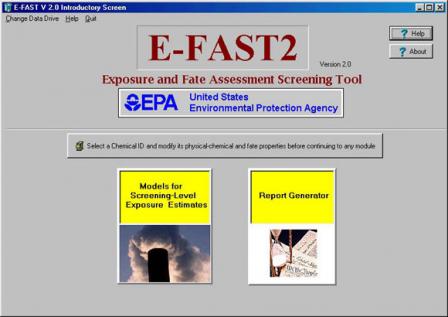
The images used herein (other than E-FAST V2.0 screen images) were obtained from IMSI's MasterClips and Master Photos Premium Image Collection, 1895 Franscisco Blvd. East, San Rafael, CA 94901-5506, USA
Course Syllabus: What is in this Introductory Course?

- What is E-FAST V2.0?
- Who Uses E-FAST V2.0?
- What are the Components of E-FAST V2.0?
- Availability of E-FAST V2.0
What is E-FAST V2.0?
E-FAST V2.0: (Exposure & Fate Assessment Screening Tool) is a screening level tool that estimates human exposure as well as aquatic ecosystem exposure to and risk from the release of chemicals to the environment.
E-FAST V2.0 estimates exposure and risk from such areas as industrial/commercial activities and the use and disposal of consumer products.
Note: A glossary of selected terms has been included in this course. If you are unsure of the meaning of a term, click on the highlighted words to access the glossary. Use the "back" button on your browser to return to the point where you left off.
What is an Exposure Assessment?
An exposure assessment for a substance or chemical tells you:
- Who is exposed (people? animals?
- The route of exposure (breathing air? drinking water? skin contact?)
- How much exposure occurs (actual or estimated?)
- How often the exposure occurs (once per day? once per week? over a lifetime?)
What is a Screening Level Tool?
E-FAST V2.0 is a screening level tool that can be used to fill in data gaps.
E-FAST V2.0:
- Uses readily available data
- Requires minimal data entry
- What are the Components of E-FAST V2.0?
- Is designed to yield conservative, protective estimates
E-FAST V2.0 requires minimal data entry
Estimating exposures isn't easy. Screening tools are helpful in filling in data gaps and use readily available data, assumptions, and exposure factors.
E-FAST V2.0 contains exposure factors based on over 20 years of EPA experience in estimating exposure. Users can add more precise data if desired. As with any model, selecting the appropriate input values is of critical importance.

The Bottom Line is: Screening level tools can be helpful in filling data gaps.
E-FAST V2.0 quickly screens exposure concerns
E-FAST V2.0 can be quickly applied to exposure scenarios because of its organizational structure and programming
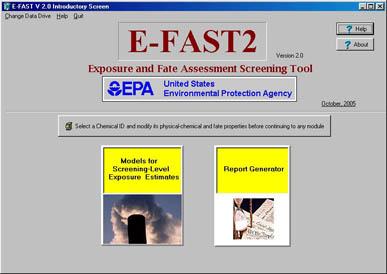
E-FAST V2.0 contains several default exposure scenarios
E-FAST V2.0 also includes several databases containing much of EPA's experience in evaluating exposures
E-FAST V2.0 is designed to provide conservative estimates of exposure:
E-FAST V2.0 is a screening tool and was designed to purposefully err on the side of safety by estimating higher than expected exposures. You should gather available data and confirm that the result from E-FAST V2.0 is conservative for your specific exposure assessment. Before using E-FAST V2.0, you should become E-FAST V2.0 is a screening tool and was designed to purposefully err on the side of safety by estimating higher than expected exposures. You should gather available data and confirm that the result from E-FAST V2.0 is conservative for your specific exposure assessment. Before using E-FAST V2.0, you should become familiar with the individual models used in the tool and their limitations and underlying assumptions. This information can be found in the help screens accessible from within E-FAST V2.0, and in the documentation manual. 
E-FAST V2.0 allows you to screen out substances with a reasonable certainty that they are of lower concern. More details on the relationship between exposure and risk are given later in this training course.
When is it inappropriate to use E-FAST V2.0?
When is it inappropriate to use E-FAST V2.0? 
- Sufficient data are available for a precise exposure and/or risk assessment
- A detailed risk assessment is required for legal, regulatory, or other purposes
- The model assumptions and/or limitations of E-FAST V2.0 suggest that it is inappropriate for the intended use
Who Uses E-FAST V2.0?
- EPA Program offices: for voluntary and regulatory purposes
- Companies: streamline operations, reduce or prevent pollution, and develop cost effective solutions to environmental challenges
- Federal, state, and local government officials: to determine chemical issues of greatest concern in their communities and jurisdictions
- Researchers , students, public groups, and consultants: to learn more about chemicals that pose potential risks to human health and the environment
- Communities: to better understand and interpret local environmental issues
Physical/Chemical/Fate Data Entry Screen
This screen is accessible from the main E-FAST V2.0 Introductory screen. Data entered here will be used in all of the modules of E-FAST V2.0. After entering the required data, click the button at the bottom center of the screen to return to the introductory screen.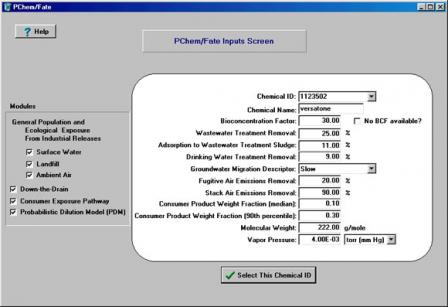
The Modules of E-FAST V2.0
- General Population and Ecological Exposure from Industrial Releases
- General Population Exposure from "Down-the-Drain" Releases of Consumer Products
- Consumer Exposure Pathway
- Probabilistic Dilution Model (PDM)
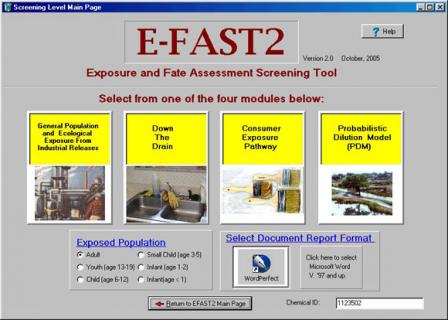
General Population and Ecological Exposure from Industrial Releases
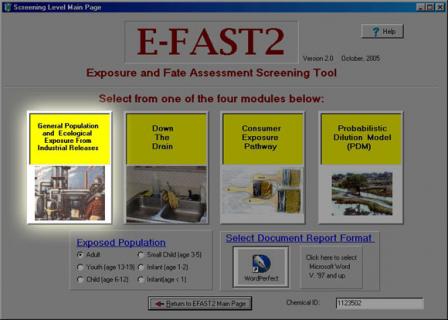
General Population Assessments From Industrial Releases:
- Releases to Water
- Site specific
- Rivers/Streams
- Lakes/Bays/Estuaries/Oceans
- Generic
- Site specific
- Releases to Land
- Direct landfill disposal of chemicals
- Landfill disposal of chemicals in sewage sludge
- Releases to Air
- Fugitive releases
- Stack releases
E-FAST V2.0 Scenario for Releases to Surface Waters (Rivers & Streams)
Human Exposure:
- E-FAST V2.0 estimates site specific drinking water exposure from industrial discharges of substances to a known location on a river or stream.
- E-FAST V2.0 estimates human exposure of eating fish exposed to industrial discharges of substances to a known location on a river or stream.
- Human exposure is estimated for potential acute (ADR) and cancer (LADD) endpoints.
Ecological Exposure/Risk:
- E-FAST V2.0 uses a site-specific technique to estimate the concentrations of a substance in surface water. This estimate can be compared to a concentration of concern to assess aquatic risk for that substance.
- E-FAST V2.0 estimates the number of days per year the concentration of concern is potentially exceeded by the estimated concentration in a stream/river.
- E-FAST V2.0 identifies endangered animal and plant species in the proximity of the discharge area.
E-FAST V2.0 Release Scenario to Surface Waters (Lakes, Bays, Estuaries & Oceans)
Human Exposure:
- E-FAST V2.0 estimates human exposure of eating fish exposed to industrial discharges of substances to a known location on a lake, bay, estuary or other "still water" site.
- Human exposure is estimated for potential acute (ADR) and cancer (LADD) endpoints.
Ecological Exposure/Risk:
- E-FAST V2.0 uses a site-specific technique to estimate the concentrations of a substance in surface water. This estimate can be compared to a concentration of concern to assess aquatic risk for that substance.
- E-FAST V2.0 identifies endangered animal and plant species in the proximity of the discharge area.
E-FAST V2.0 Release Scenario to Surface Waters at an Unspecified Location
Human Exposure:
- E-FAST V2.0 estimates drinking water exposure from industrial discharges of substances to unspecified locations based on generic Standard Industrial Classification
- E-FAST V2.0 estimates human exposure of eating fish exposed to industrial discharges of substances to unspecified locations based on generic Standard Industrial Classification
- Human exposure is estimated for potential acute (ADR) and cancer (LADD)
Ecological Exposure/Risk:
- Uses a generic SIC code technique to estimate the concentrations of a substance in surface water. This estimate can be compared to a concentration of concern to assess aquatic risk for that substance.
- E-FAST V2.0 estimates the number of days per year the concentration of concern is potentially exceeded by the estimated concentration in a stream/river.
E-FAST V2.0 Landfill Release Scenario
Human Exposure:
- E-FAST V2.0 estimates drinking groundwater exposure from disposal of industrial wastes or sludge to a generic
 landfill.
landfill. - Human exposure is estimated for cancer (LADD) endpoints.
E-FAST V2.0 Air Release Scenario (Stack Release)
This scenario is designed to estimate inhalation exposures downwind of a stack releasing to the atmosphere, e.g., after incineration. Factors considered include stack and facility parameters, and meteorological and terrain information. 
Human exposure is estimated for potential acute (ADR) and cancer (LADD) endpoints.
E-FAST V2.0 Air Release Scenario (Fugitive Release)
This scenario is designed to estimate inhalation exposures from fugitive releases. A fugitive release occurs when a substance is released to the air from such places as pipe connections, tanks and loading/unloading operations.
Human exposure is estimated for potential acute (ADR) and cancer (LADD) endpoints.
Down The Drain Exposure
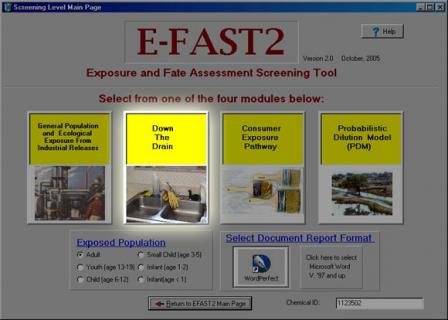
How does E-FAST V2.0 screen exposure to humans and the aquatic ecosystem from "down-the-drain" releases of consumer products?
Exposure from residential releases of consumer products:
- Human Exposure via surface water releases
- Ecological Exposure via surface water releases
E-FAST V2.0 Scenario for Releases of "Down-the-Drain" Consumer Products from a Generic Residence
Human Exposure:
- This scenario estimates drinking water and fish ingestion exposures resulting from disposal of consumer products at a generic residence through a generic public sewer system.
- Human exposure is estimated for potential acute (ADR) and cancer (LADD) endpoints
Ecological Exposure/Risk:
- E-FAST V2.0 estimates the concentration of a substance in surface water and compares it to a concentration of concern in order to assess aquatic risk for that substance.
- E-FAST V2.0 estimates the number of days per year the concentration of concern is potentially exceeded by the concentration in a generic stream or river.
Consumer Exposure Pathway
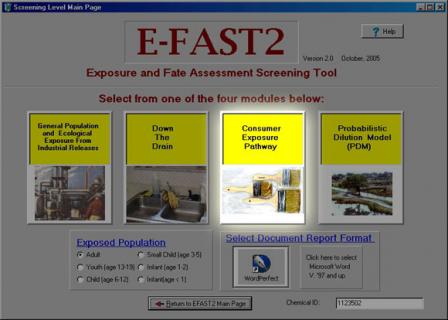
How Does E-FAST V2.0 screen exposure from the use of consumer products?
Dermal Exposure:
- Pre-set scenarios based on EPA experience
- User-defined scenarios
Inhalation Exposure:
- Pre-set scenarios based on EPA experience
- User-defined scenarios
E-FAST V2.0 Scenarios for Consumer Products - Skin (Dermal) Exposure
Users may run the model with a user-defined scenario if the product of concern or other input parameters differ from these default scenarios:
- Products applied to a surface (latex paint, general purpose cleaner)
- Products added to water (laundry detergent)
- Products with direct skin contact (used motor oil, bar soap)
E-FAST V2.0 Scenarios for Consumer Products - Inhalation Exposure
Users may run the model with a user-defined scenario if the product of concern or other input parameters differ from these default scenarios:
- Products applied to a surface (latex paint, general purpose cleaner, fabric protector)
- Products added to water (laundry detergent)
- Products sprayed on surfaces (spray paint)
- Products released to the environment (air fresheners)
Probabilistic Dilution Model (PDM)
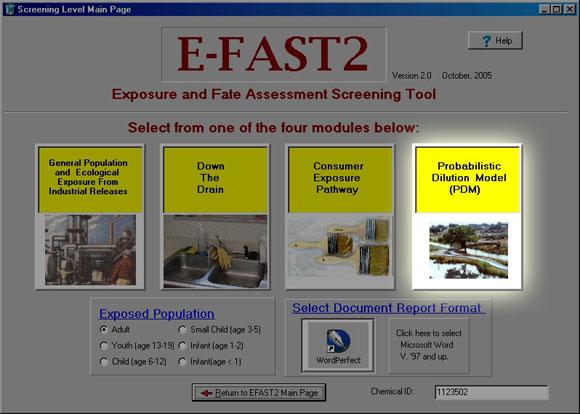
Probabilistic Dilution Model (PDM)
Aquatic Ecosystem Exposure/Risk Pathway
- For a known site: Site-Specific
- For a generic site: Standard Industrial Classification (SIC) code
E-FAST V2.0 Scenario for ecological exposure/risk from surface water releases (site-specific)
Uses a site specific technique to estimate the concentrations of a substance in surface water. This estimate can be compared to a concentration of concern. This comparison of estimated concentration to concentration of concern is used to assess aquatic risk for that substance.
E-FAST V2.0 estimates the days per year the concentration of concern is potentially exceeded by the estimated concentration in a stream/river.
Ecological exposure/risk from surface water releases (SIC code)
Uses a generic SIC code technique to estimate the concentrations of a substance in surface water. This estimate can be compared to a concentration of concern. This comparison of estimated concentration to concentration of concernis used to assess aquatic risk for that substance.
E-FAST V2.0 estimates the days per year the concentration of concern is potentially exceeded by the estimated concentration in a stream/river
How can the exposure assessment results be used?
- Quickly evaluate and prioritize chemicals based on exposure
- Separate chemicals into different levels of concern to help decide whether to devote additional resources for advanced exposure assessments, collection of monitoring data or use of more complex models
- Use readily available data for exposure assessment. Whenever possible, reliable measured data is preferred over model estimates
What is Risk?
Risk = (Exposure) x (Hazard)Exposure and hazard assessments are combined into a risk assessment which is used to evaluate whether there is a potential risk (probability of an adverse effect). E-FAST V2.0 provides an entire screening level risk assessment for aquatic ecosystems. However, E-FAST V2.0 only provides the exposure, but not the hazard, component for assessing potential risks to humans.
What is a Hazard Assessment and how is it used?
A hazard assessment provides an understanding of the potential for the chemical to cause adverse effects to humans, animal and plant life.
E-FAST V2.0 users should find appropriate hazard data from a variety of EPA sources (e.g. the Integrated Risk Information System (IRIS), the Agency for Toxic Substances and Disease Registry (ATSDR), the Hazardous Substances Data Bank (HSDB), or the Aquatic Information Retrieval Database (AQUIRE)) in conjunction with exposure data to evaluate risk.
System Availability
E-FAST V2.0 is now available through direct download on the Internet at EPA's website.
If you have already downloaded E-FAST V2.0, please check for periodic updates of the system.
Need More Information?
Conrad Flessner at flessner.conrad@epa.gov
For Additional Information on E-FAST V2.0 including the E-FAST V2.0 documentation manual, check out the E-FAST V2.0 web site
For Information on the Environmental Protection Agency, check out the EPA web site























